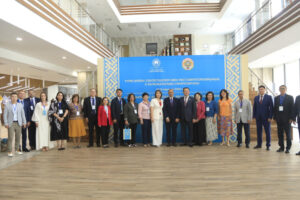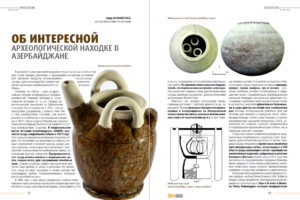Tokyo, 21 September, /AJMEDIA/
Chairman of the Culture Committee of the Azerbaijani Parliament, MP Ganira Pashayeva’s book “Japan Step by Step” (Baku, CBS PP, 2021) has been published. The editor of the book is Akbar Goshali, the foreword writer is Gursel Ismayilzadeh, Ambassador Extraordinary and Plenipotentiary of the Republic of Azerbaijan to Japan, and the book reviewers are Dr. Tarana Turan Rahimli and Vugar Agayev, the special representative the AZERTAC in Japan.
Japan means the difference. It is very difficult to write about Japan, to see and describe its multicultural culture, the beauty of the union of antiquity and modernity, to create an image of Japan in the imagination of a reader who has never seen this country. Professor Ganira Pashayeva, Chairperson of the Culture Committee of the National Parliament (Milli Mejlis) of the Republic of Azerbaijan, member of the Azerbaijan-Japan Inter-parliamentary Working Group, successfully overcame this difficulty in her book “Step by Step, Japan”. In the book we see a whole panorama of Japan, which gives a clear idea of all spheres of Japanese life, unites our ideas about the wise philosophy of life, moral standards, and high human qualities of this beautiful nation. The national and spiritual wealth of Japan, values, Japanese national psychology, philosophy of religion, absorbed into the way of life, centuries-old traditions come to life before our eyes.
It should be noted that although works and books about Japan have been published in Azerbaijan in recent years, their number is insufficient and does not give an exhaustive idea of the uniqueness of Japanese life. On the other hand, many of these books are full of distortions because Japanese personal names and place names are based on Russian translations. It should be noted that the name of this mysterious country is called Japan by many peoples as a distortion of the Russians.
It is especially pleasant to see the complete opposite of this picture in the book by Ganira Pashayeva “Step by Step, Japan”. In addition to completeness of information about the country, accuracy of facts and documents, the author was extremely scrupulous to write each name as it is in the original, to correctly mark difficult Japanese words that are distorted in many languages.
The book contains a perfect portrait of a free Japan, which over the centuries has managed to realize its happiness, depicting the deep lines of thinking and contemplation of the Japanese. Ganira Pashayeva connects the reasons for the unforgettable nature of this portrait with the unwritten laws of Japanese life, as well as with the realities of the distant past. The distinctive features that distinguish the Japanese from the peoples of the world, as well as from other peoples of the Far East, who have many common values, are the focus of the author’s attention in all sections of the book.
After reading the book “Step by Step Japan”, you will once again be convinced that the past centuries have not torn anything away from the Japanese as a nation, have not changed their views on the world, way of life and customs. Although science and technology have advanced, the Japanese have never given up their simple lifestyle and age-old habits, even though they are the first in this area.
Ganira Pashayeva sees the secret of the mystery and beauty of Japan in the hearts of people who make the country so unforgettable, believing in the idea that “if the universe has one heart, then every heart is the universe,” as it is said in Zen. philosophy. He writes about this nation, which possesses aesthetics and is capable of decorating life: “In general, Japanese thought in any case strives for the existence of hidden, mysterious beauty. This thought is closer to those who have a beautiful heart and who feel beauty”.
Speaking about the Japanese as one of the most polite peoples in the world, Ganira Pashayeva emphasized that “in Japan, no one interferes in each other’s affairs,” “it’s embarrassing to stare at someone, even if they are awake. trains or subways, everyone closes their eyes and falls asleep. “There is no swearing in Japanese.” “The biggest fight between a man and a woman is probably to close the door a little harder.” As you read these lines, you are forced to remember that the participle “O”, which is a form of politeness and is used at the beginning of a sentence, exists only in Japanese grammar. “O genki desu ka?” (Means: “Please tell me how you are doing?”). Even when asked about your condition, this is a courtesy only for the Japanese in the world.
The book of Professor Ganira Pashayeva “Step by Step, Japan” fully reflects all spheres of Japanese national identity. From the geographical position of Japan to the place of Zen philosophy in Japanese life, from the flora and fauna of the country to various sports, to the details of the national culture, such as tea rituals, differences in cuisine, the book of Ganira Pashayeva. I am of the opinion that, in the words of Mrs. Ganira, who gives peace to the human spirit, it is impossible to write about this country “like in a movie” better. Because in this book, which takes the reader by the hand and leads him through different cities of Japan, we find traces of a great history from the first Japanese Yamato dynasty to the great Nara era, the Heian, Kamakura, Muromachi, Edo periods, the Meiji revolution in modern Japan. The author focuses on the development of Japan from ancient times to the present day, which dates back to 300-710 BC.
The author describes the status of each city in Japanese life with great sympathy from the country’s most modern city, the metropolis of Tokyo, with special respect and admiration from ancient Kyoto, the capital of a great empire, with care and compassion for Hiroshima and Nagasaki, who survived the greatest tragedy in the history of mankind … He also gives a complete picture of the places that define the beauty and uniqueness of these cities, and gives the necessary recommendations to future visitors.
The book also reflects in detail the work done to develop Azerbaijani-Japanese relations. The author praises Japan as one of the first countries to recognize the national independence of Azerbaijan. If we talk about problems, then this gives a complete picture of the history of these relations.
Emphasizing the further development of relations and all-round cooperation between the two countries after the official visit of Azerbaijani President Ilham Aliyev to Japan on March 7-10, 2006, the author views this visit as an important step towards a new stage of interstate relations.
As a member of the Azerbaijan-Japan inter-parliamentary working group, Pashayeva’s meetings with the Japanese public also serve to expand these ties, as well as to convey the realities of Azerbaijan, as in Japan. It should be noted that it is especially important to convey to the Japanese the truth about Khojaly and the realities of the Karabakh war without distortions.
The book also highlights the work done to expand cultural ties between Azerbaijan and Japan. It is noteworthy that this book about Japan was published in Azerbaijan as an example of tolerance and bodybuilding in modern times, when serious attention is paid to the integration of national cultures. As one of the book’s reviewers, I read the book with admiration, which gave a complete picture of the wide panorama of Azerbaijani-Japanese relations. And I believe that Step by Step Japan is a valuable contribution to the development of cooperation between the two countries.
Tarana Turan Rahimli,
Doctor of Philosophy, Associate Professor









































